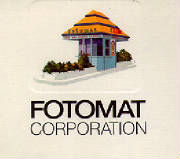Fotomat
 | |
| Company type | Subsidiary |
|---|---|
| Founded | 1965inSan Diego, California |
| Founder | Preston Fleet |
| Parent |
|

Fotomatwas an American retail chain ofphotodevelopmentdrive-throughkioskslocated primarily in shopping center parking lots. Fotomat Corporation was founded byPreston FleetinSan Diego, California,in the 1960s, with the first kiosk opening inPoint Loma, California,in 1965. Fotomat became a public company in 1971 and was listed on theNew York Stock Exchange(NYSE) in 1977.[1]At its peak around 1980, there were over 4,000 Fotomats throughout theUnited States,primarily in suburban areas. Fotomats were distinctive for their pyramid-shaped gold-colored roofs and signs with blue and red lettering. Usually positioned in a large parking area, such as a supermarket orstrip mall,the Fotomat huts required a minimal amount of land and were able to accommodate cars driving up to drop off or pick up film.[2]Fotomat soldKodakand Fotomat brand film, as well as other photography-related products, and offered overnight photo finishing. Many people assumed Fotomat was owned by Kodak, because of the yellow roofs and font similar to Kodak packaging. Fotomat also made filmstrips (35mm single frame) for school, when teachers wanted to have a custom captioned or sound filmstrip made, the Teacher could use the Fotomat filmstrip development service, but teachers would have to take the pictures on blank 35mm single frame film and record the soundtrack on a cassette tape, then they would take them to the Fotomat booth, and the film and cassette tape would be sent to the Fotomat Lab to be produced.


Fotomat had both company-owned stores andfranchises.This led to lawsuits between Fotomat and its franchisees over territories.[3][4]
In the early 1980s, Fotomat Corporation was acquired byKonishiroku Photo IndustryLtd., also known asKonicaPhoto Imaging, in 1986. Eventually, it was sold toViewpoint Corporationin 2002.[5][6]
The company's main product, overnight film development, was rendered noncompetitive by the late 1980s development of theminilab,which provided one-hour photo development and could be installed on-site without a large capital investment. After the introduction ofdigital cameras,overnight service eventually became obsolete and Fotomat switched to online digital imaging at Fotomat where users could edit and store their images. This site ceased operations September 1, 2009.[7]
Many former Fotomat huts still exist, several having been converted into drive-thru coffee kiosks.[8]Competitors of Fotomat includedFoto Hut,Fox Photo,andKodakitself.
Video rental service
[edit]In addition to photo developing, Fotomat was one of the first companies to offer movies for rent onvideocassette—a new concept then—starting in December 1979. Customers would browse through a small catalog, call a number and order the movie or movies of their choice. The following day, the customer would pick up the cassette at the Fotomat kiosk of their choice. The rental cost was $12 per title (equivalent to $50 in 2023) and the customer could keep it for five days. The price was later reduced to $9.95 for a five-day rental. The service was called "Fotomat Drive-Thru Movies."[9][10]
Initially, onlyParamount Picturesentered into an agreement with the chain to offer their movies for rent. Fotomat also offered lesser-known titles from smaller distributors such as Brandon Chase's Group I Releasing and VCI from Tulsa, Oklahoma (one of the first independent video labels at the dawn of the format), but these releases would not be prominently credited to these sources as the Paramount titles. Fotomat also carried certain exclusive releases, such asI Go Pogo.[11] These titles were distributed directly by Fotomat and were of a uniform design with a black, die-cut cardboard case and a black label that included a white title (as well as Paramount's stylized logo for their films), but otherwise no artwork or color. In addition, a Fotomat logo accompanied by a four-tone sound would play before the start of each movie. The logo included an artistic representation of the company's yellow mansard roof.[12][13]
On March 4, 1980,Walt Disney Home Entertainmentbegan offering their first videos for rental through Fotomat.[14]Later on, MCA struck a deal with Fotomat to distribute its titles through rental.[citation needed]
By 1982, local video stores had begun to offer customers cheaper video rentals without the overnight wait time and Fotomat discontinued the service.
References
[edit]- ^NY TimesPreston Fleet, 60, Creator of Fotomat And Omnimax, Dies, Published: February 04, 1995
- ^LA TimesObituaries: Preston Fleet, 60; Fotomat Founder February 03, 1995
- ^aw.justiaEichman v. Fotomat Corp. (1983)147 Cal. App. 3d 1170 [197 Cal. Rptr. 612
- ^openjurist.org641 F. 2d 581 – Ogilvie v. Fotomat Corporation Griesedieck Enterprises No Inc.
- ^orlandosentinelBUSINESS, Fotomat Corp, By Deanne Brandon, April 23, 1985
- ^LA TimesRoeder to Leave as Chairman of Fotomat, March 05, 1985
- ^tatteredandlostphotographs7/18/10, Between drug stores and Shutterfly there was FOTOMAT
- ^What became of America’s Drive-Thru Fotomat?
- ^entmerch.org, Entertainment Merchants AssociationArchived2017-01-27 at theWayback MachineIndustry History, A History of Home Video and Video Game Retailing, 1975–1979
- ^BillboardBlank VHS Boom,Oct 27, 1979
- ^IMDbI Go Pogo (1980): The initial release was via Fotomat in mid-September 1980 on VHS and Betamax videotapes, in a plain generic Fotomat box with a plain label. The beta tape retailed for $54.95.
- ^youtubeFotomat Home Video Logo Theme from VHS rental
- ^vintagetoledotvArchived2011-05-19 at theWayback MachineFotomat: Beta & VHS tapes – January 1980, add
- ^thisdayindisneyhistory.homestead1980: Disney releases its very first video tapes to the home VHS market. The 13 titles are licensed for rental to Fotomat
External links
[edit]- Photography companies of the United States
- Companies based in San Diego
- Photographic retailers
- Kiosks
- Companies formerly listed on the New York Stock Exchange
- American companies established in 1965
- Retail companies established in 1965
- 1965 establishments in California
- 1980s mergers and acquisitions
- 2002 mergers and acquisitions
